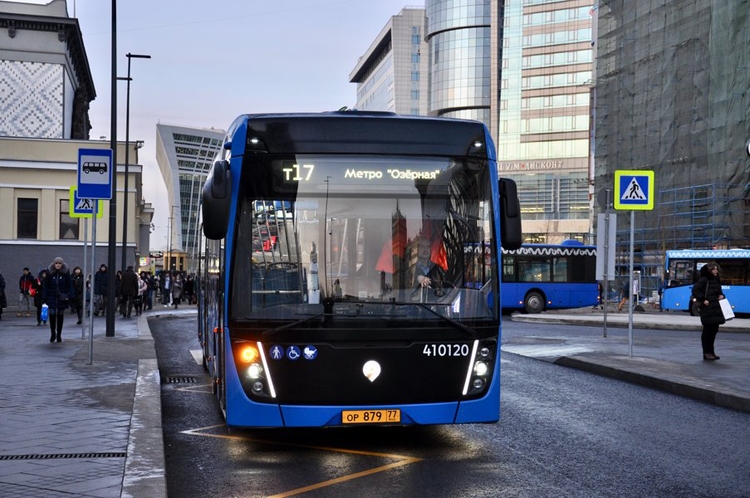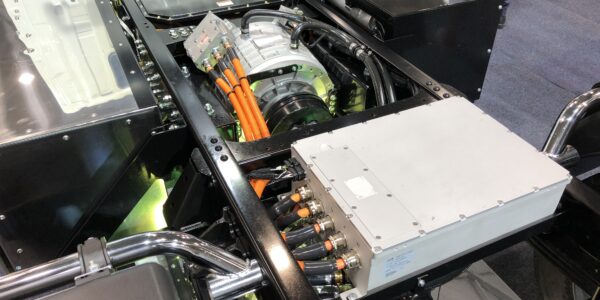Electric bus fleets continue to grow, spurred on by new models and ever-advancing tech
- PostedPublished 10 December 2020

Californian heavy electric vehicle manufacturer Proterra has unveiled a new electric bus called the ZX5 that is claimed to be capable of a substantial 529km battery range between charges.
The company says its fifth-generation electric bus has been specifically engineered to meet the increasingly demanding requirements of customers, with a design that maximises the amount of space available for batteries. Its highest-capacity 12-metre variant packs 660kWh of energy storage, more than 10 times that of a Hyundai Kona Electric.
Its impressive 500km+ range will make the ZX5 a more viable option for some operators, thanks to its reduced reliance on charging and its ability to travel further between stops. Proterra has also focused on aspects such as streamlining the design of the bus, and lowering its ride height, in order to improve its route access.
Proterra offers 11- and 12-metre versions, which seat 29 or 40 passengers respectively, and they can be specified with a Proterra single- or dual-motor drivetrain. The basic 11-metre ZX5 comes with a 220kWh battery pack, which grants a maximum range of 201km; its single 250kW motor can also accelerate it from 0-32km/h in 5.9 seconds and, flat out, the ZX5 will hit a tyre- and Proterra-governed top speed of 105km/h.
The 440kWh version is capable of covering 386km on a single charge but, going for the 12-metre bus unlocks the option of 660kWh of on-board energy storage – providing the maximum 529km range. This heavier and more capable bus is still capable of 0-32km/h in 6.4 seconds, thanks in part to its motors’ combined peak output of 410kW, and it can reach the same 105km/h.

For comparison, a conventional diesel bus of a similar size might pack an engine producing 200kW. The ZX5’s acceleration and power, compared with earlier Proterra models, also means that it can handle more challenging routes; the dual-motor DuoPower model, for example, is claimed to be capable of ascending a 25 per cent grade.
The absence of a complicated diesel engine and emissions system further helps bring running costs down, while high-performance charging should keep turnaround times manageable. A variety of charging solutions are supported but Proterra claims that 27-51km of range can be added every 10 minutes, depending on specification and charger type.
From empty, using a 330kW overhead charger, the 660kWh version of the ZX5 is reputed to take approximately three hours to charge.
Electric school buses, shuttle buses and a delivery truck are also offered by Proterra, along with fleet planning services, logistical support and charging infrastructure – and it has more than 120 customers in North America, to which it has now delivered more than 1000 electric buses.
Proterra products are also making their way over to Australia, with Queensland-based Bustech to begin using Proterra battery technology in its 325km-capable electric ZDi transit bus.
“Our best-in-class battery technology platform has been proven in more than 13 million service miles (21 million kilometres) driven by our fleet of battery-electric transit buses in the United States and Canada,” said Proterra chairman and CEO Jack Allen.
“Now, we look forward to delivering the benefits of Proterra-powered clean, quiet electric vehicles to even more people around the world.”
Electric bus market hots up
An increasing number of electric buses are being offered, driven in part by increasingly stringent emissions regulations and the need to adopt more sustainable transport; BYD, New Flyer Industries, Volvo, ZF and Mercedes-Benz – and Proterra – are among those offering zero-emissions transit vehicles and components.
Fleets are beginning to introduce and use these buses in significant numbers, too. In Madrid, a total of 30 BYD 40-foot electric buses have just been ordered for use in the city.
These new buses will join an existing 15 BYD eBuses, introduced in May, which are reputed to have proven both cost-effective while demonstrating extensive single-charge range.
Finland also recently took delivery of 106 BYD eBuses, including the new 15-metre, 50-passenger eBus model, which has a claimed range of 400km.

BYD now has 400 eBuses on delivery or in service in Scandinavia, which will result in significant environmental benefits; transport operator Nobina AB, which is headquartered in Stockholm, has been running BYD eBuses for five years – and, in that time, they have racked up seven million kilometres and reduced the company’s CO2 emissions by some 7500 tonnes.
Other countries that have taken delivery of BYD buses in the past few months include Hungary and Germany, but it’s not only heavily trafficked regions that are adopting zero-emissions buses.
Auckland-based transport and tourism company Fullers360 has bought eight BYD ADL Enviro200EV buses, which are being put into service on New Zealand’s Waiheke Island.
These buses, which can each carry 37 passengers and travel up to 400km on a single charge, are joining other pure electric buses already in operation in Auckland, Christchurch, and Tauranga.
Auckland mayor Phil Goff said: “Vehicle emissions make up more than 40% of Auckland’s carbon emissions, so electrifying the Waiheke Island bus fleet to create a more sustainable public transport network will help us reduce overall emissions and further progress our climate change goals.”

Existing e-bus fleets expanding
In Moscow, there are currently 450 electric buses providing public transport – but, by 2024, more than 2600 electric buses are expected to be in service.
If that target is reached, it will mean that more than a third of all public transport buses in the city will have been electrified.
Domestic manufacturers Gaz and Kamaz will supply the buses, which are required to have a service life of 15 years.
Bus-based electric RVs go off-grid
It’s not only buses, commercial transport and passenger vehicles that are increasingly having a green and sustainable eye cast over them.
US-based caravan manufacturer Living Vehicle, which specialises in adaptable off-grid trailers, recently partnered with Volta Power Systems, a lithium-ion energy storage specialist in Michigan.
Together, the two have developed a luxury trailer that features 47.6kWh of energy storage and 3.8kW of solar power. Aside from powering the trailer, an optional 240-volt charging system is offered so that owners can charge their EVs.

“Many of our customers have down-payments on electric trucks like Tesla’s Cybertruck or the Rivian, which require access to reliable charging for long-term off-grid use,” said Matthew Hofmann, co-founder and lead designer of Living Vehicle.
“With the ability to export high-voltage power from the Volta system, Living Vehicle models will be able to quickly and sustainably charge these tow vehicles or companion cars using stored energy.”
New cooling tech boosts bus charging
Charging an electric bus while it is out on the road – with automated pantograph chargers, for example – can be ideal for improving the capability of an electric fleet without overstretching a depot’s charging facilities.
In order to ensure sufficient power is delivered during these brief stops, which are often located at the end of a route, high-output chargers are required.
These more powerful chargers generate more heat, however, and hot power electronics can suffer from reliability issues and short service life.
A compressor-based refrigeration system can be used to keep them cool, but they can be involved, noisy and energy-intensive.

Instead, to avoid such issues, transport modernisation company SBRS collaborated with technology company Technotrans to deliver a line of chargers that use quieter and low-consumption liquid cooling.
The ambient temperature cooling system from Technotrans features redundant pumps and cooling fans, which are controlled to maximise reliability while minimising noise.
If the coolant temperature climbs, the fans are gradually throttled up – making it easy to maintain the desired temperature without producing noise that could exceed regulated limits.
SBRS chargers using Technotrans cooling systems have been in operation since 2017 and the companies, both of which are based in Germany, are now working together on several other projects throughout Europe.
- CategoriesIn SightGlass
- Tagselectric bus, electric vehicles, SightGlass News Issue 22




